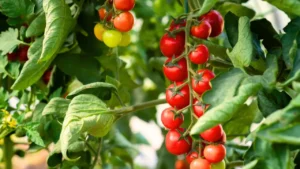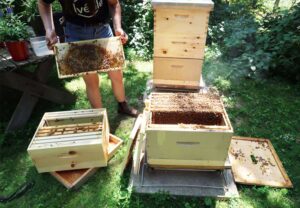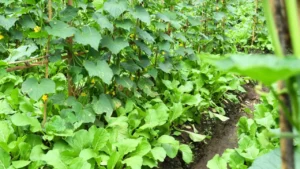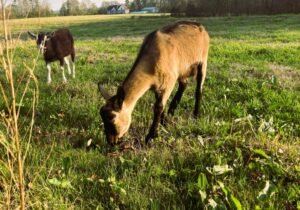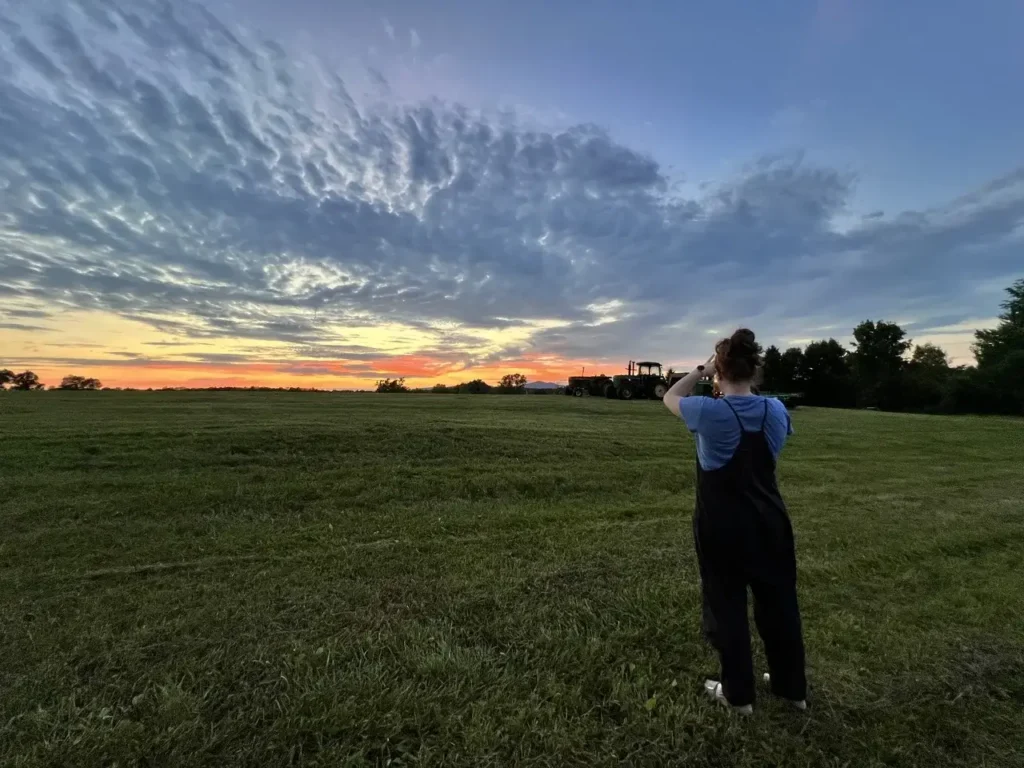
IMG 3422 1 jpg.webp.webp
Most July mornings, Charlotte Maffie rises with the alarm at 5:30 a.m., sleepily dons her “stinky, stinky chore clothes” and heads to the red barn to begin the daily morning tasks of greeting and caring for the 60 cows and 40 chickens at Catskill Waygu at Hilltop Farm in upstate New York.

In the 90-minute ritual, she distributes buckets of grain and hay for the cows’ breakfast, scrapes away animal feces, fills the water trough bucket by bucket, milks the dairy cows, feeds the barnyard cats and new kittens, and shepherds sometimes recalcitrant cows out to pasture. Next, she replenishes feed and water for the chickens and lets them out into their area.
It’s a lot of work. “To be honest, I take a nap every single morning,” laughs Maffie, who is studying chemistry at Bates College. “But I’ve learned more about cows and chickens than I ever knew before.” She’s part of the Anne Saxelby Legacy Fund (ASLF), a unique month-long immersive farm apprenticeship program that provides farm internships and apprentice opportunities to students and career changers.
LEARN MORE
Find out why new farmers often face hurdles when starting out, and how one apprenticeship program wants to fix that.
The ASLF was founded in 2022 by the family and friends of pioneering cheesemonger Anne Saxelby of Saxelby Cheesemongers after her sudden passing. Saxelby, a beloved figure in the cheese world, championed American farmstead cheese, leading to its rise in prominence. Working on farms was life changing for her and instilled a desire to support small producers and change our industrial food system.
“We need to educate this next generation of farmers” in order to bring about systemic change, says Susie Cover, the ASLF’s executive director. Those who enter farming-adjacent careers will also be better equipped to make change. Learning the art of affinage (the process of aging cheese), herd management like Maffie, or how to properly prune plants to encourage stem growth are experiences that students will “never get by learning in a classroom,” she says. “The hands-on part is the most important.”
“The hands-on part is the most important.”
Nearly 100 apprentices are working in 60 farms across the country; one is employed at London’s famed Neal’s Yard Dairy. Placements include produce, animal, hemp, and dairy farms, and cheesemaking and salumi operations in locations aligned with the fund’s mission and values of quality sustainable agriculture.
The program has doubled in size each year; 500 applications were received in 2024, a result of extensive outreach at agriculture, culinary, food studies, and trade programs, postings on job list serves, as well as word of mouth. However, no farm experience is required, stresses Cover, just the ability to handle the physical work and to take initiative. The ASLF is also working to become a college-accredited program.
Apprentices are paid an hourly wage of $20 for a 40-hour workweek and an expense stipend; the ASLF covers transportation and housing costs, removing barriers for prospective applicants and for farms to receive much-needed help.There are frequent check-ins with the apprentices and farms to ensure all is going smoothly.

For apprentices, not having to worry about costs is a huge relief. “To [be able to] put my all into it made me want to put more energy and effort into making the most of this program,” says Mona Ziabari, an apprentice at Fisheye Farms, a sustainably run urban farm in Detroit. A student with limited funds, she’s unsure if she could have applied.
Zibari is a food studies major at New York University and an accomplished cook who envisions a career in the culinary arts. “It is super important to learn about the food production side because I think a lot of people in our society are not educated on what it looks like,” she says.
Zibari had worked in restaurants, but she was taken aback by the physical stamina farming requires. Fisheye’s owners arranged to have a bicycle for Ziabari to bike to work from another urban farm where she is housed, and to stage at farm-to-table restaurants on her days off to broaden her understanding.

“We wouldn’t have been able to have apprentices if they weren’t paid for,” says Ryan McPherson, owner of Glidden Point Oyster Farms in Maine. The ASLF approached McPherson this year to include an aquaculture opportunity. It also added five urban farms to its roster.
McPherson was impressed by the caliber of the applicants, farms, and vetting process. He appreciates the opportunity to share knowledge, since farmed aquaculture is still a very young industry and its connection to and overlap with agriculture is not yet well explored. “It is important,” says McPherson, “to be in those conversations.” Since his farm’s two apprentices had prior terrestrial farming experience, he expects that they’re able to share insights into similarities and differences into the two types of farming. The apprentices have been grading out and redistributing seed, conducting farm maintenance, and washing and packing oysters for sale and shipping.

To Bliss Battle, an alumna of New York City’s Brooklyn Grange, the financial support signaled that “people wanted to see me succeed,” she says. Battle left art school to try farming because it “involved manual labor and being in nature.” She says she “came out way more confident in my skills, like how to use all the tools, and in production-level farming,” and developed an appreciation of growing food for mutual aid and not for profit. She was later hired at another farm by a former Grange supervisor.
Battle is now attending welding school so she can repair farm machinery. “I want to be an asset to my community,” she says. “And my sense of community has been more solidified through the work I’ve been doing as a farmhand.”
“I want to be an asset to my community.”
Ziabari’s eyes were also opened by a blend of practical knowledge and sociocultural perspectives. “I’ve been learning how culture and race intersect with food production,” she says, noting that “food deserts are prevalent” in the more diverse areas of Detroit, already a multi-racial and ethnic city.
Ziabari credits the city’s growing urban farm movement for improving food access for marginalized communities. The farms have a “progressive approach to incorporating culture,” she says, growing produce that is meaningful to residents in a nod to the city’s history.
“It’s just crazy how people don’t think about it in that way,” she says. “I’m one of them. You’re not forced to think about it unless you’re doing it, having conversations about it, or actually having to get on your knees and do the work.”
READ MORE
Find out more about the growing urban farm movement in Detroit.
The experience Maffie gained with farms, cows and cheesemaking—her farm’s owner is developing a cheese program—fit her interest in food science.
She was also surprised at some of the lesser-known ways politics and government affect farms. She learned that farms are required to pay for the USDA inspectors who inspect their meat, which can “put a strain on both butchers and small farms,” says Maffie, because larger farms can slaughter so many more animals that the cost becomes nominal. Also, since only one USDA inspector shows up at a slaughterhouse, the animals on smaller farms wind up subject to more scrutiny than animals at larger ones. With higher volumes, employees there assist the lone USDA inspector who can’t watch each process at once.

Remarkably, while some feeder programs may be more diverse than in the past, the ASLF team was surprised that nearly 70 percent of this year’s applications came from women. Farming though is a white and male-dominated profession; the number of female farmers has held steady in recent years, according to USDA data.
“I think it is probably a backlash to the fact that it is a male-dominated field,” says Maffie. “Now, there’s a bunch of women who are like, ‘No, I want to do that, too,’ so I’m going to start setting myself up to do that.”
Surprisingly, women “outnumber males in aquaculture in Maine,” says McPherson. He bought his farms from women owners and his staff is well over half female.
“I think it is really cool that people can see [food production] as a career option, especially young women,” says Battle. She says programs such as the ASLF can have a huge impact on people’s lives. “Your formative years, you can see a subversive career path and that it is sustainable. And you can go where you want with it,” she adds.
TAKE ACTION
Want to get started? Check out our guide for young farmers.
Source link
2024-08-30 07:30:34
Karl Hoffman is a distinguished agriculturalist with over four decades of experience in sustainable farming practices. He holds a Ph.D. in Agronomy from Cornell University and has made significant contributions as a professor at Iowa State University. Hoffman’s groundbreaking research on integrated pest management and soil health has revolutionized modern agriculture. As a respected farm journalist, his column “Field Notes with Karl Hoffman” and his blog “The Modern Farmer” provide insightful, practical advice to a global audience. Hoffman’s work with the USDA and the United Nations FAO has enhanced food security worldwide. His awards include the USDA’s Distinguished Service Award and the World Food Prize, reflecting his profound impact on agriculture and sustainability.
